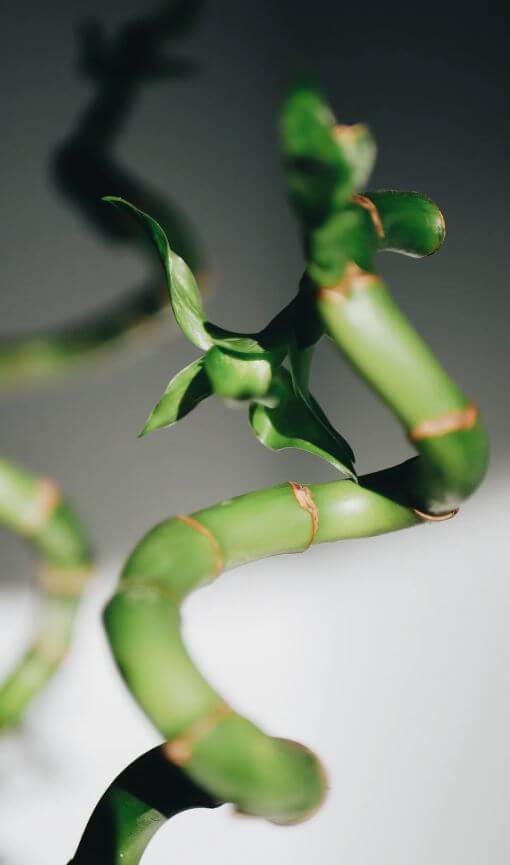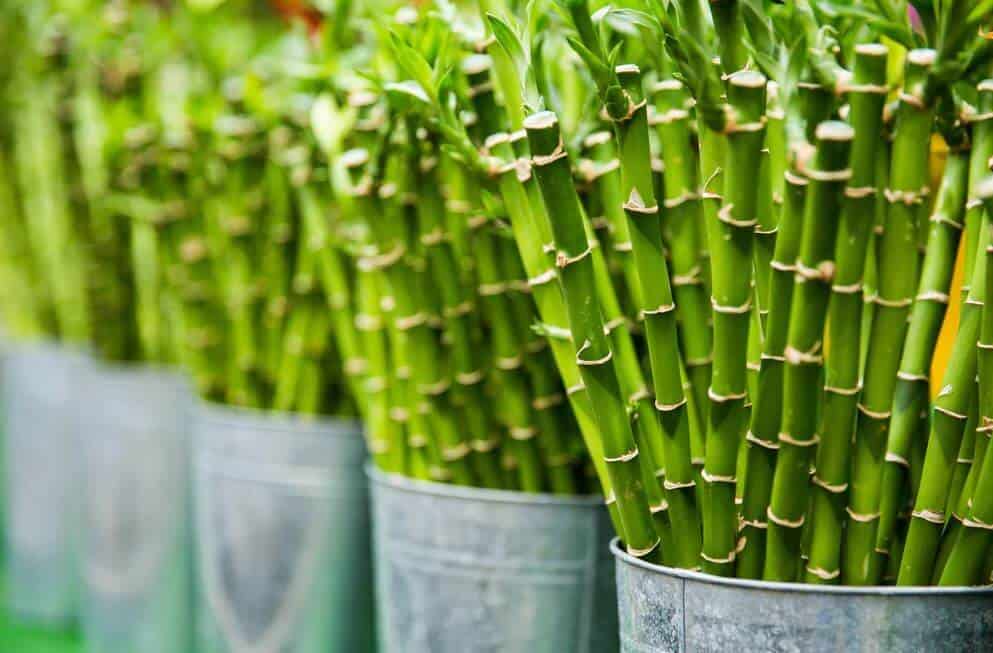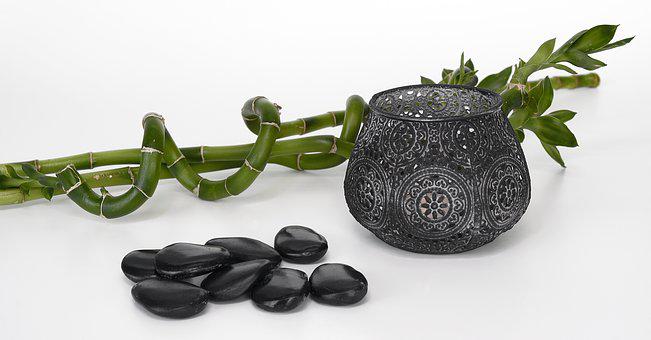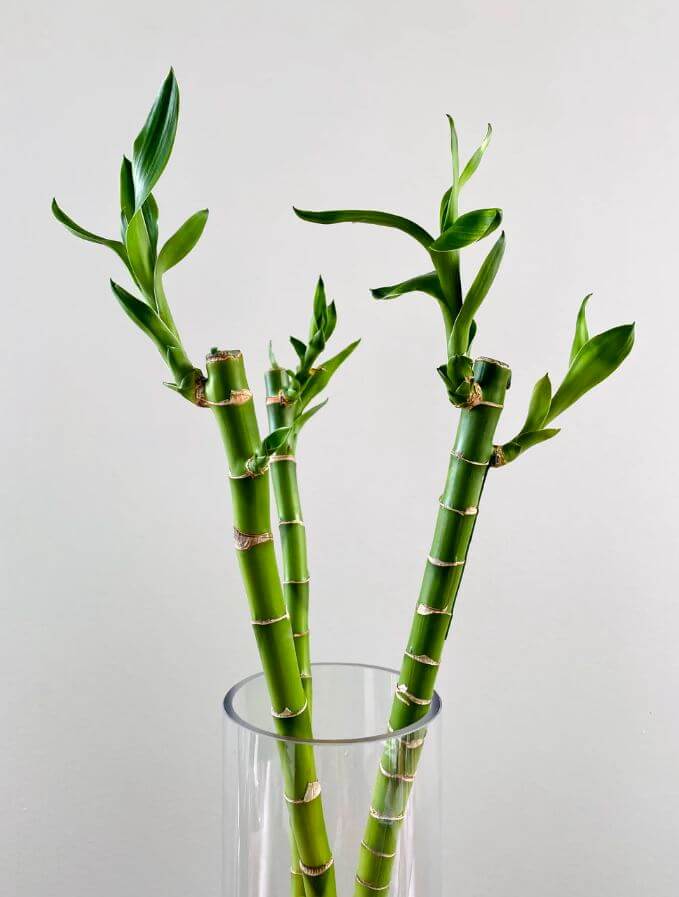Last Updated on January 9, 2023 by a Friendly Gardener
Lucky Bamboo is a happy addition to any location. This delightful houseplant is thought to bring good fortune to home gardens and especially if received as a gift. It also has a reputation as resilient and indestructible, so it is the perfect plant for beginners and those who do not have a lot of time for home gardening.
Originally native to Africa, botanically known as the Dracaena sanderiana, it belongs to the Asparagaceae family. Today most of these plants originate in China and Taiwan. Nurseries in Asian countries design beautiful sculptures by twisting, curling, or braiding the plant’s stalks with the results being beautiful one-of-a-kind designs. This plant, however, is not related to bamboo, even if the stems certainly resemble it. It would be better characterized as being like a succulent.

Popularly known as Lucky Bamboo, Friendship Bamboo, Chinese Water Bamboo, or the Ribbon Plant, these plants are usually purchased from nurseries or florists and not grown at home from seed. It is classified as a perennial shrub. If cultivated indoors it can grow anywhere from one to three feet tall and one to two feet in width.
Lucky Bamboo Care

The first step in caring for a Lucky Bamboo plant is to provide the proper environmental conditions. This plant is a survivor and is quite resilient even when care is a little lax. Considered to be lucky, the number of stalks the plant has will have significance. Three stalks stand for happiness and health, while eight stalks signify prosperity and development, so consider how many stalks your plant has if buying one from your nursery or florist.
Soil
This fortune-bearing plant requires an organically rich well-draining soil bed. While soil should not be waterlogged, it should have sufficient water retention to remain moist. Add one part of vermiculite or peat moss to two parts of quality potting soil.
The Lucky Bamboo can also be cultivated in a container of pebbles as an alternative. Another option is to cultivate your plant in a vase consistently filled with one or more inches of water. When cultivating your plant in water, create a system of anchorage to support your plant by adding pebbles or rocks.
Light

Lucky Bamboo prefers filtered bright light or dappled light as it would if growing underneath a canopy of taller vegetation or trees. Avoid exposing this plant direct sunlight to prevent burning foliage. Plants that reach upward or in one specific direction may be reaching for the light. Fading color is also a sign that your plant needs more light. The Lucky Bamboo is capable of adjusting to low light conditions.
Water and Humidity
Lucky Bamboo is highly sensitive to chemical compounds, especially chlorine, often found in city water sources. If your tap water is rife with chemicals, opt to cultivate your plant using distilled water. If you must use tap water, leave the water out for 24 hours to allow any chlorine to evaporate. For Lucky Bamboo plants grown in water as opposed to soil, red roots indicate a healthy plant. When cultivating in water, change it weekly.
Average home humidity levels are perfect for the Lucky Bamboo plant.
Temperature
Lucky Bamboo prefers warmer climates with temperatures measuring between 65° and 90° Fahrenheit. Avoid placing your plant where it will be exposed to drafts of any type, regardless of hot or cold air. Heating elements or vents, air conditioning units or vents, drafty windows, and hallways are inappropriate for positioning your plant.
Feeding
Compost and manure are among the best fertilizers for your Lucky Bamboo. If these are not available, add a single drop of liquid fertilizer to your Lucky Bamboo monthly. If you cultivate this plant in water, add one drop bi-monthly. Dilute liquid fertilizer although you may find a fertilizer specifically formulated for this plant.
Pruning
Pruning is important to overall plant health. As this plant matures, it will most likely become a bit top-heavy. If you bought or received the plant fashioned into a specific design, as it grows it will begin to lose this shape.
Do not trim the main stalk of the plant. Trim away offshoots with sterile gardening shears to about one inch in length from the main stem. Shortly thereafter new stems will emerge. This trimming aids in having your plant appear bushier. If you prefer no new growth, dip the stalk’s cut end in paraffin to discourage it.
Repotting

Lucky Bamboo is a rapid grower, so choose a proper plant. The type of Lucky Bamboo will also influence the pot you choose. A few species are known as “runners”, meaning that plant shoots will grow in all directions. Climber species grow straight upwards in direction. Do select a pot that measures twice the diameter of the Lucky Bamboo’s root ball.
If your plant outgrows its container, you can choose a larger container or trim roots and replace the soil using the same plant container.
Lucky Bamboo Propagation

Propagation is easy using stem cuttings. Cut a healthy section that features at least one joint. Several joints are preferable. Trim away any excess foliage and leave the leaf node exposed.
Plant cuttings can be placed in a jar of distilled water. Change the cuttings water to maintain cleanliness. When roots appear, transfer your Lucky Bamboo to potting soil.
If you wish to root your cutting in soil, remember that at least one growth node should be planted beneath the level of the soil or a pebble base.
Lucky Bamboo Shaping

Lucky Bamboo can be shaped into a variety of forms, but not as in the art of the Bonsai which uses wiring and pruning. The Lucky Bamboo uses light for shaping. Bamboo stalks are moved and rotated to cause the plant to turn naturally in the direction of a light source.
By using rotation, you cause your plant to twist, curl, or bend. This method does require time.
New soft shoots near the main stem can also be curled. A more rapid method of manipulating new stalks is to use training wire, as in Bonsai wiring, and wrap it around stalks to twist them.
To encourage straight upward stalks, use a pole to keep stalks erect. Also, use ribbon or wire to bind stalks together, but avoid tightening too much.
Lucky Bamboo Toxicity

The Lucky Bamboo is low in risk of poisoning for humans. It does, nonetheless, contain saponins that place felines at risk. Lucky Bamboo poisoning in felines can cause anorexia, vomiting, depression, excessive drooling or salivation, and dilated pupils. Contact your veterinarian immediately if your cat has ingested any part of this plant.
Pests, Diseases, and Problems
Lucky Bamboo’s greatest problem will be the water used in its jar or container or when watering.
- High chlorine levels in the water supply, will turn foliage brown at the tips and eventually kill the plant.
- Black roots should be trimmed away.
- Never leave dead leaves in the water to rot as this will develop into a source of bacteria.
- Algae growth in water should be cleaned and water replaced. If algae growth persists, use an opaque glass vase.
- Yellowing foliage indicates too much sunlight or excessive feeding. Do not feed further and move your plant to a shadier position.
- Brown leaves will alert you to polluted water or excessively dry air. Change the water and mist every few days to improve the environmental humidity.
- Mushy stems implicate rot, and the plant should be discarded. All decayed stalks need to be removed as they place the rest of the plant at risk.
Pests common to house plants can torment the Lucky Bamboo. Remove them manually or use an organic insecticide.
In Conclusion

The unique and intriguing Lucky Bamboo is resistant to neglect and forgiving. It asks very little in return for a bit of uniquely shaped greenery wherever it is located.

